Nursing Care Case Study : Assignment
VerifiedAdded on 2021/09/19
|7
|1860
|37
AI Summary
Contribute Materials
Your contribution can guide someone’s learning journey. Share your
documents today.
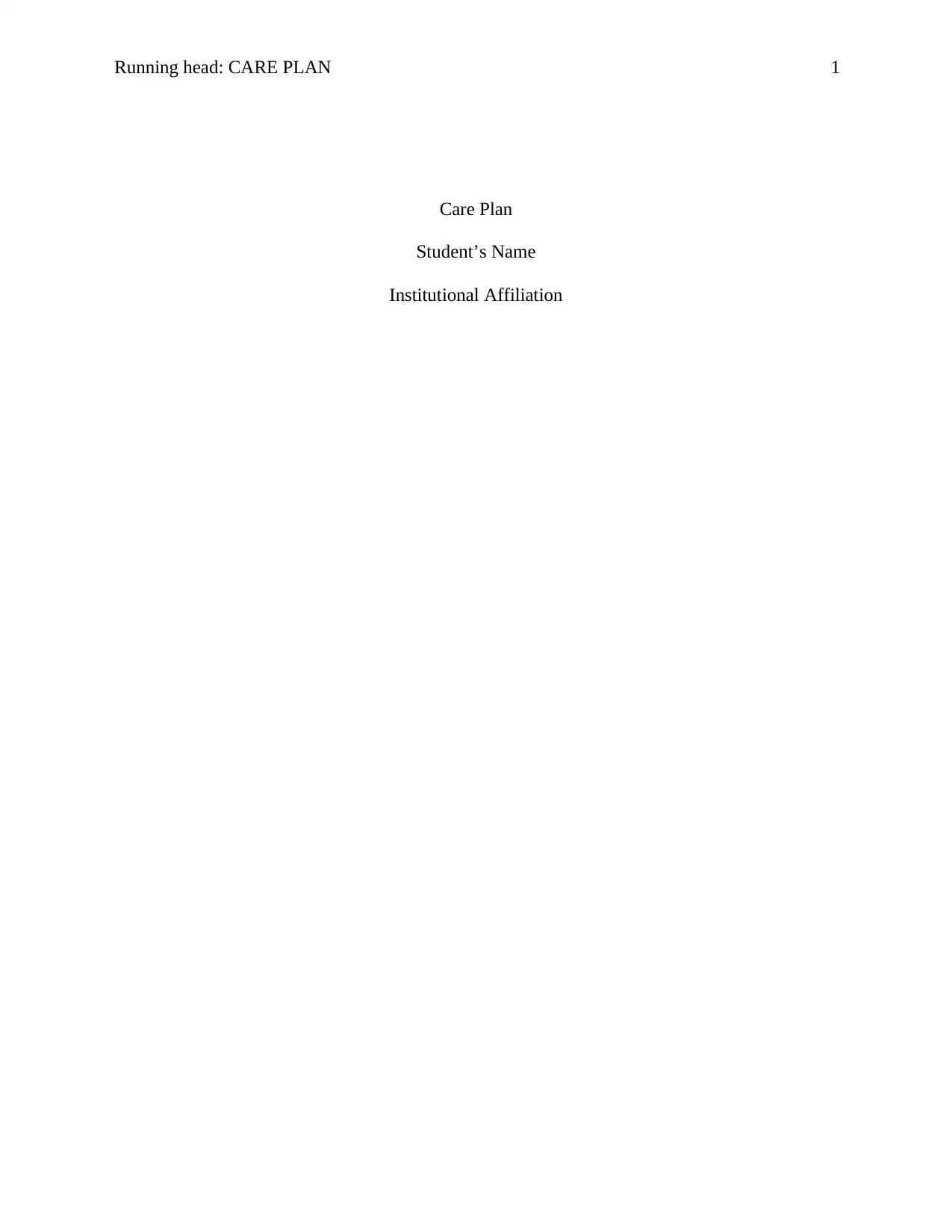
Running head: CARE PLAN 1
Care Plan
Student’s Name
Institutional Affiliation
Care Plan
Student’s Name
Institutional Affiliation
Secure Best Marks with AI Grader
Need help grading? Try our AI Grader for instant feedback on your assignments.
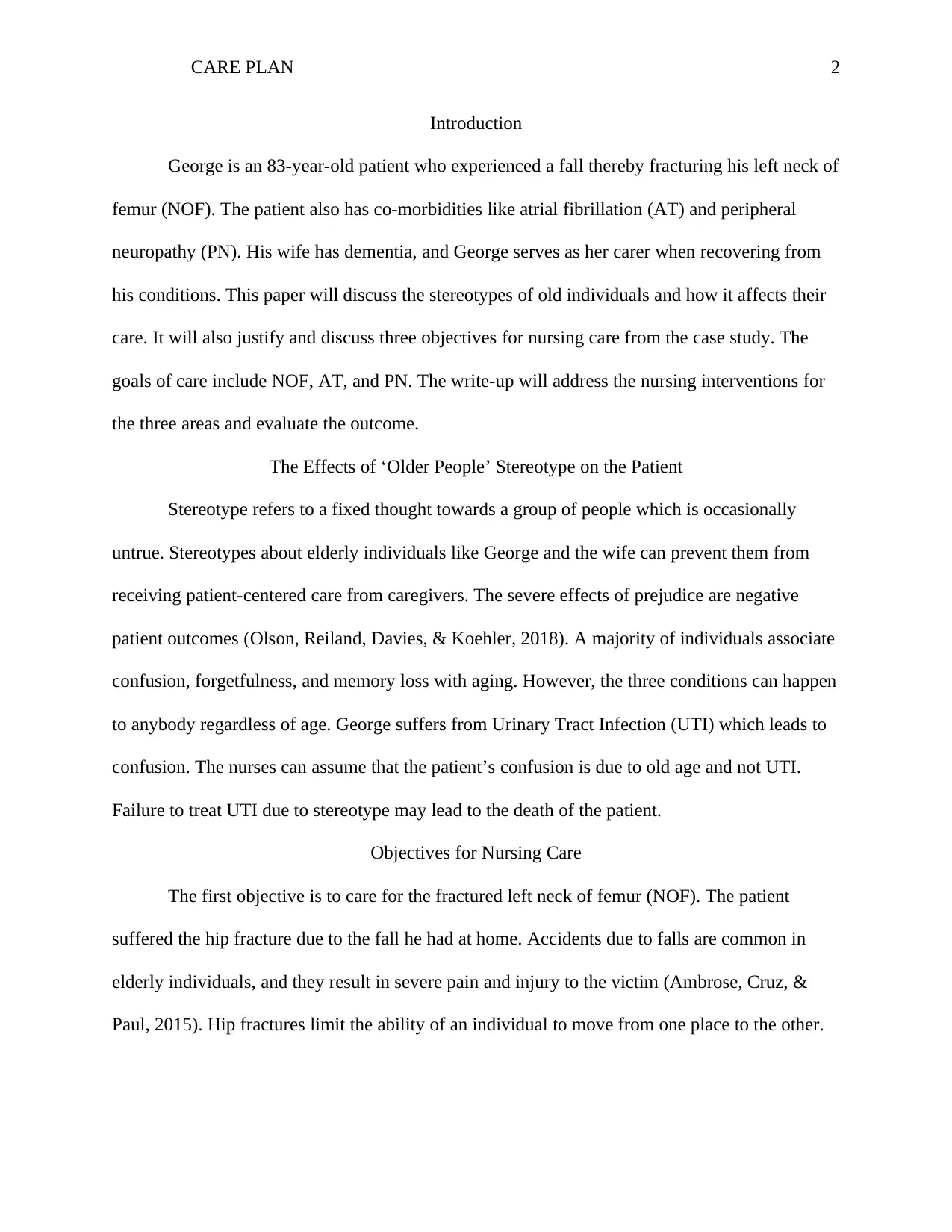
CARE PLAN 2
Introduction
George is an 83-year-old patient who experienced a fall thereby fracturing his left neck of
femur (NOF). The patient also has co-morbidities like atrial fibrillation (AT) and peripheral
neuropathy (PN). His wife has dementia, and George serves as her carer when recovering from
his conditions. This paper will discuss the stereotypes of old individuals and how it affects their
care. It will also justify and discuss three objectives for nursing care from the case study. The
goals of care include NOF, AT, and PN. The write-up will address the nursing interventions for
the three areas and evaluate the outcome.
The Effects of ‘Older People’ Stereotype on the Patient
Stereotype refers to a fixed thought towards a group of people which is occasionally
untrue. Stereotypes about elderly individuals like George and the wife can prevent them from
receiving patient-centered care from caregivers. The severe effects of prejudice are negative
patient outcomes (Olson, Reiland, Davies, & Koehler, 2018). A majority of individuals associate
confusion, forgetfulness, and memory loss with aging. However, the three conditions can happen
to anybody regardless of age. George suffers from Urinary Tract Infection (UTI) which leads to
confusion. The nurses can assume that the patient’s confusion is due to old age and not UTI.
Failure to treat UTI due to stereotype may lead to the death of the patient.
Objectives for Nursing Care
The first objective is to care for the fractured left neck of femur (NOF). The patient
suffered the hip fracture due to the fall he had at home. Accidents due to falls are common in
elderly individuals, and they result in severe pain and injury to the victim (Ambrose, Cruz, &
Paul, 2015). Hip fractures limit the ability of an individual to move from one place to the other.
Introduction
George is an 83-year-old patient who experienced a fall thereby fracturing his left neck of
femur (NOF). The patient also has co-morbidities like atrial fibrillation (AT) and peripheral
neuropathy (PN). His wife has dementia, and George serves as her carer when recovering from
his conditions. This paper will discuss the stereotypes of old individuals and how it affects their
care. It will also justify and discuss three objectives for nursing care from the case study. The
goals of care include NOF, AT, and PN. The write-up will address the nursing interventions for
the three areas and evaluate the outcome.
The Effects of ‘Older People’ Stereotype on the Patient
Stereotype refers to a fixed thought towards a group of people which is occasionally
untrue. Stereotypes about elderly individuals like George and the wife can prevent them from
receiving patient-centered care from caregivers. The severe effects of prejudice are negative
patient outcomes (Olson, Reiland, Davies, & Koehler, 2018). A majority of individuals associate
confusion, forgetfulness, and memory loss with aging. However, the three conditions can happen
to anybody regardless of age. George suffers from Urinary Tract Infection (UTI) which leads to
confusion. The nurses can assume that the patient’s confusion is due to old age and not UTI.
Failure to treat UTI due to stereotype may lead to the death of the patient.
Objectives for Nursing Care
The first objective is to care for the fractured left neck of femur (NOF). The patient
suffered the hip fracture due to the fall he had at home. Accidents due to falls are common in
elderly individuals, and they result in severe pain and injury to the victim (Ambrose, Cruz, &
Paul, 2015). Hip fractures limit the ability of an individual to move from one place to the other.
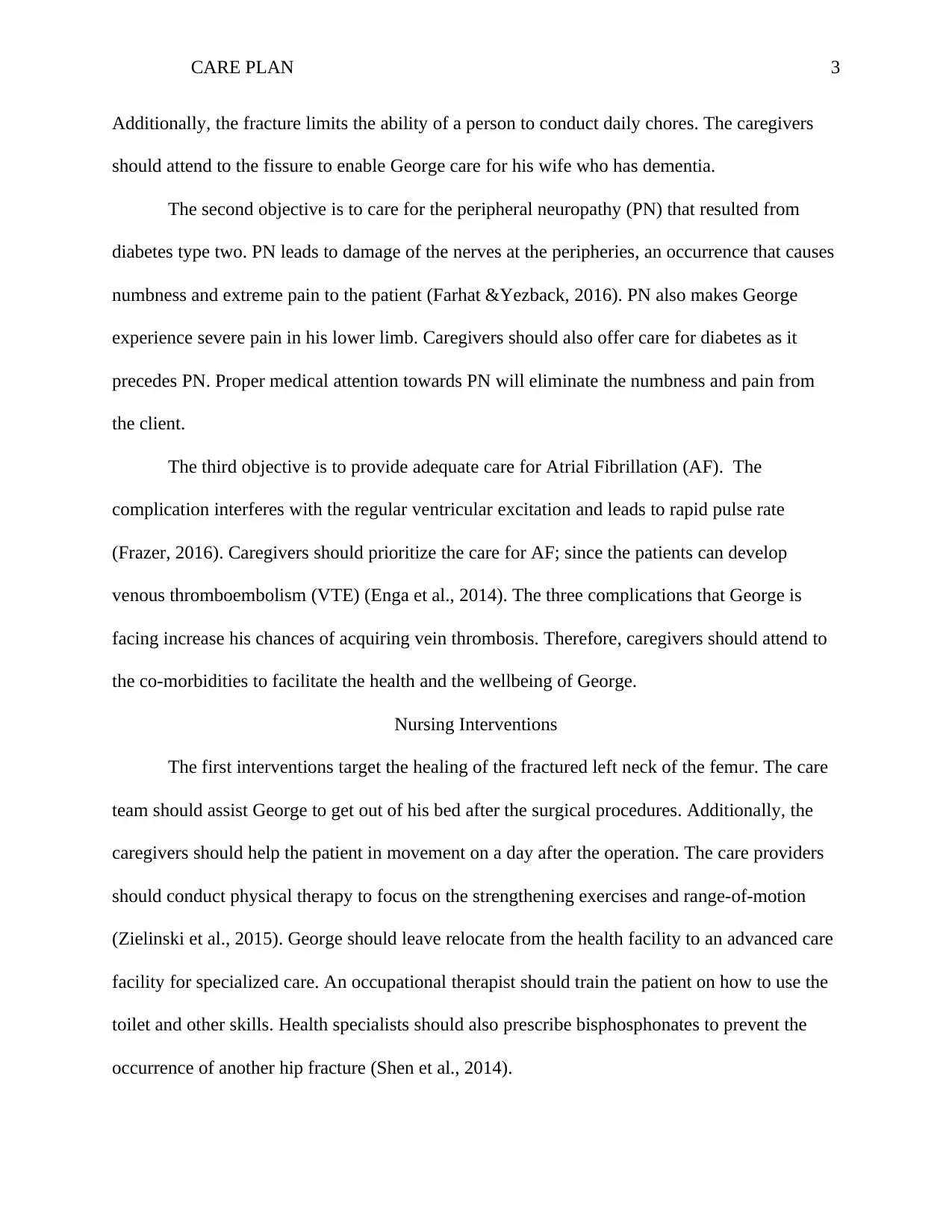
CARE PLAN 3
Additionally, the fracture limits the ability of a person to conduct daily chores. The caregivers
should attend to the fissure to enable George care for his wife who has dementia.
The second objective is to care for the peripheral neuropathy (PN) that resulted from
diabetes type two. PN leads to damage of the nerves at the peripheries, an occurrence that causes
numbness and extreme pain to the patient (Farhat &Yezback, 2016). PN also makes George
experience severe pain in his lower limb. Caregivers should also offer care for diabetes as it
precedes PN. Proper medical attention towards PN will eliminate the numbness and pain from
the client.
The third objective is to provide adequate care for Atrial Fibrillation (AF). The
complication interferes with the regular ventricular excitation and leads to rapid pulse rate
(Frazer, 2016). Caregivers should prioritize the care for AF; since the patients can develop
venous thromboembolism (VTE) (Enga et al., 2014). The three complications that George is
facing increase his chances of acquiring vein thrombosis. Therefore, caregivers should attend to
the co-morbidities to facilitate the health and the wellbeing of George.
Nursing Interventions
The first interventions target the healing of the fractured left neck of the femur. The care
team should assist George to get out of his bed after the surgical procedures. Additionally, the
caregivers should help the patient in movement on a day after the operation. The care providers
should conduct physical therapy to focus on the strengthening exercises and range-of-motion
(Zielinski et al., 2015). George should leave relocate from the health facility to an advanced care
facility for specialized care. An occupational therapist should train the patient on how to use the
toilet and other skills. Health specialists should also prescribe bisphosphonates to prevent the
occurrence of another hip fracture (Shen et al., 2014).
Additionally, the fracture limits the ability of a person to conduct daily chores. The caregivers
should attend to the fissure to enable George care for his wife who has dementia.
The second objective is to care for the peripheral neuropathy (PN) that resulted from
diabetes type two. PN leads to damage of the nerves at the peripheries, an occurrence that causes
numbness and extreme pain to the patient (Farhat &Yezback, 2016). PN also makes George
experience severe pain in his lower limb. Caregivers should also offer care for diabetes as it
precedes PN. Proper medical attention towards PN will eliminate the numbness and pain from
the client.
The third objective is to provide adequate care for Atrial Fibrillation (AF). The
complication interferes with the regular ventricular excitation and leads to rapid pulse rate
(Frazer, 2016). Caregivers should prioritize the care for AF; since the patients can develop
venous thromboembolism (VTE) (Enga et al., 2014). The three complications that George is
facing increase his chances of acquiring vein thrombosis. Therefore, caregivers should attend to
the co-morbidities to facilitate the health and the wellbeing of George.
Nursing Interventions
The first interventions target the healing of the fractured left neck of the femur. The care
team should assist George to get out of his bed after the surgical procedures. Additionally, the
caregivers should help the patient in movement on a day after the operation. The care providers
should conduct physical therapy to focus on the strengthening exercises and range-of-motion
(Zielinski et al., 2015). George should leave relocate from the health facility to an advanced care
facility for specialized care. An occupational therapist should train the patient on how to use the
toilet and other skills. Health specialists should also prescribe bisphosphonates to prevent the
occurrence of another hip fracture (Shen et al., 2014).
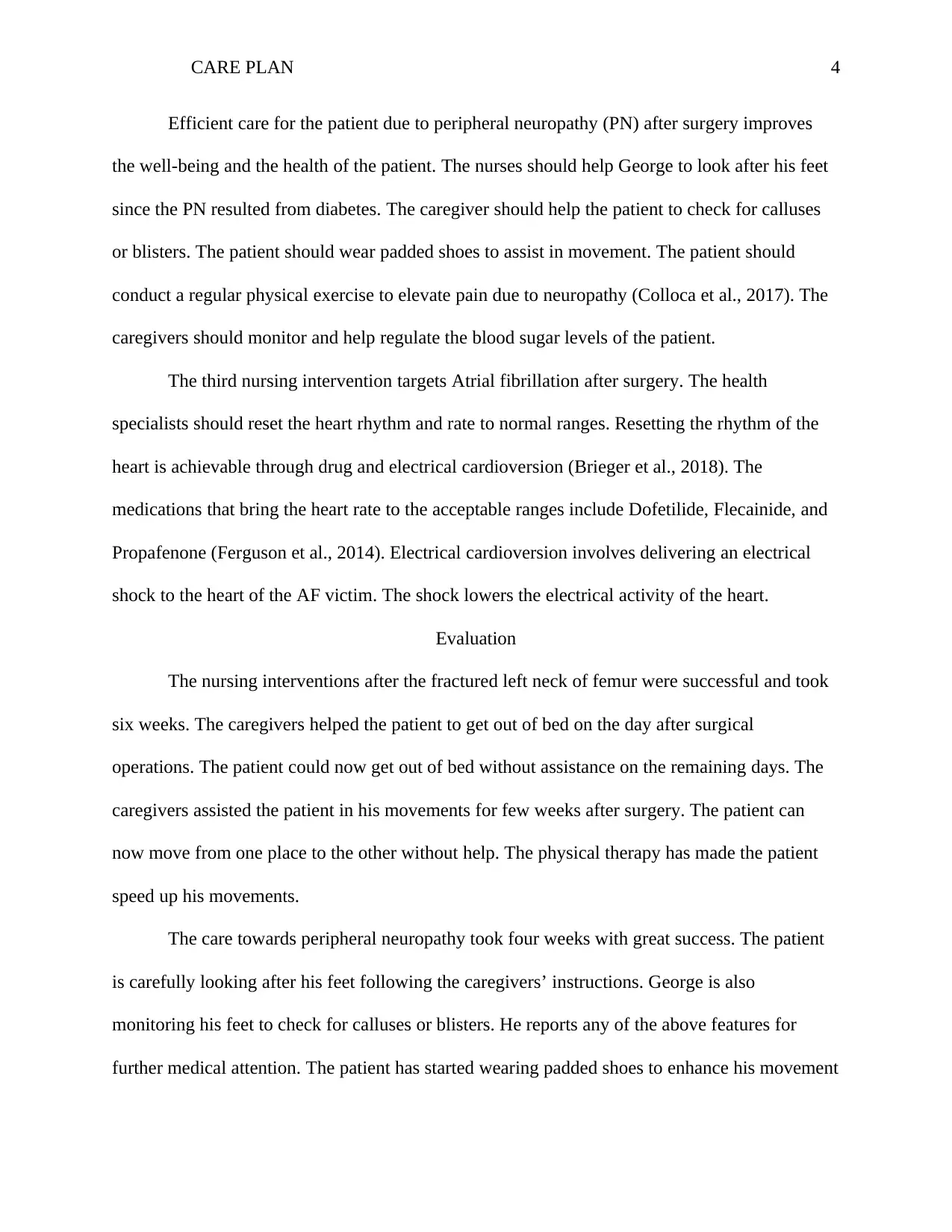
CARE PLAN 4
Efficient care for the patient due to peripheral neuropathy (PN) after surgery improves
the well-being and the health of the patient. The nurses should help George to look after his feet
since the PN resulted from diabetes. The caregiver should help the patient to check for calluses
or blisters. The patient should wear padded shoes to assist in movement. The patient should
conduct a regular physical exercise to elevate pain due to neuropathy (Colloca et al., 2017). The
caregivers should monitor and help regulate the blood sugar levels of the patient.
The third nursing intervention targets Atrial fibrillation after surgery. The health
specialists should reset the heart rhythm and rate to normal ranges. Resetting the rhythm of the
heart is achievable through drug and electrical cardioversion (Brieger et al., 2018). The
medications that bring the heart rate to the acceptable ranges include Dofetilide, Flecainide, and
Propafenone (Ferguson et al., 2014). Electrical cardioversion involves delivering an electrical
shock to the heart of the AF victim. The shock lowers the electrical activity of the heart.
Evaluation
The nursing interventions after the fractured left neck of femur were successful and took
six weeks. The caregivers helped the patient to get out of bed on the day after surgical
operations. The patient could now get out of bed without assistance on the remaining days. The
caregivers assisted the patient in his movements for few weeks after surgery. The patient can
now move from one place to the other without help. The physical therapy has made the patient
speed up his movements.
The care towards peripheral neuropathy took four weeks with great success. The patient
is carefully looking after his feet following the caregivers’ instructions. George is also
monitoring his feet to check for calluses or blisters. He reports any of the above features for
further medical attention. The patient has started wearing padded shoes to enhance his movement
Efficient care for the patient due to peripheral neuropathy (PN) after surgery improves
the well-being and the health of the patient. The nurses should help George to look after his feet
since the PN resulted from diabetes. The caregiver should help the patient to check for calluses
or blisters. The patient should wear padded shoes to assist in movement. The patient should
conduct a regular physical exercise to elevate pain due to neuropathy (Colloca et al., 2017). The
caregivers should monitor and help regulate the blood sugar levels of the patient.
The third nursing intervention targets Atrial fibrillation after surgery. The health
specialists should reset the heart rhythm and rate to normal ranges. Resetting the rhythm of the
heart is achievable through drug and electrical cardioversion (Brieger et al., 2018). The
medications that bring the heart rate to the acceptable ranges include Dofetilide, Flecainide, and
Propafenone (Ferguson et al., 2014). Electrical cardioversion involves delivering an electrical
shock to the heart of the AF victim. The shock lowers the electrical activity of the heart.
Evaluation
The nursing interventions after the fractured left neck of femur were successful and took
six weeks. The caregivers helped the patient to get out of bed on the day after surgical
operations. The patient could now get out of bed without assistance on the remaining days. The
caregivers assisted the patient in his movements for few weeks after surgery. The patient can
now move from one place to the other without help. The physical therapy has made the patient
speed up his movements.
The care towards peripheral neuropathy took four weeks with great success. The patient
is carefully looking after his feet following the caregivers’ instructions. George is also
monitoring his feet to check for calluses or blisters. He reports any of the above features for
further medical attention. The patient has started wearing padded shoes to enhance his movement
Secure Best Marks with AI Grader
Need help grading? Try our AI Grader for instant feedback on your assignments.
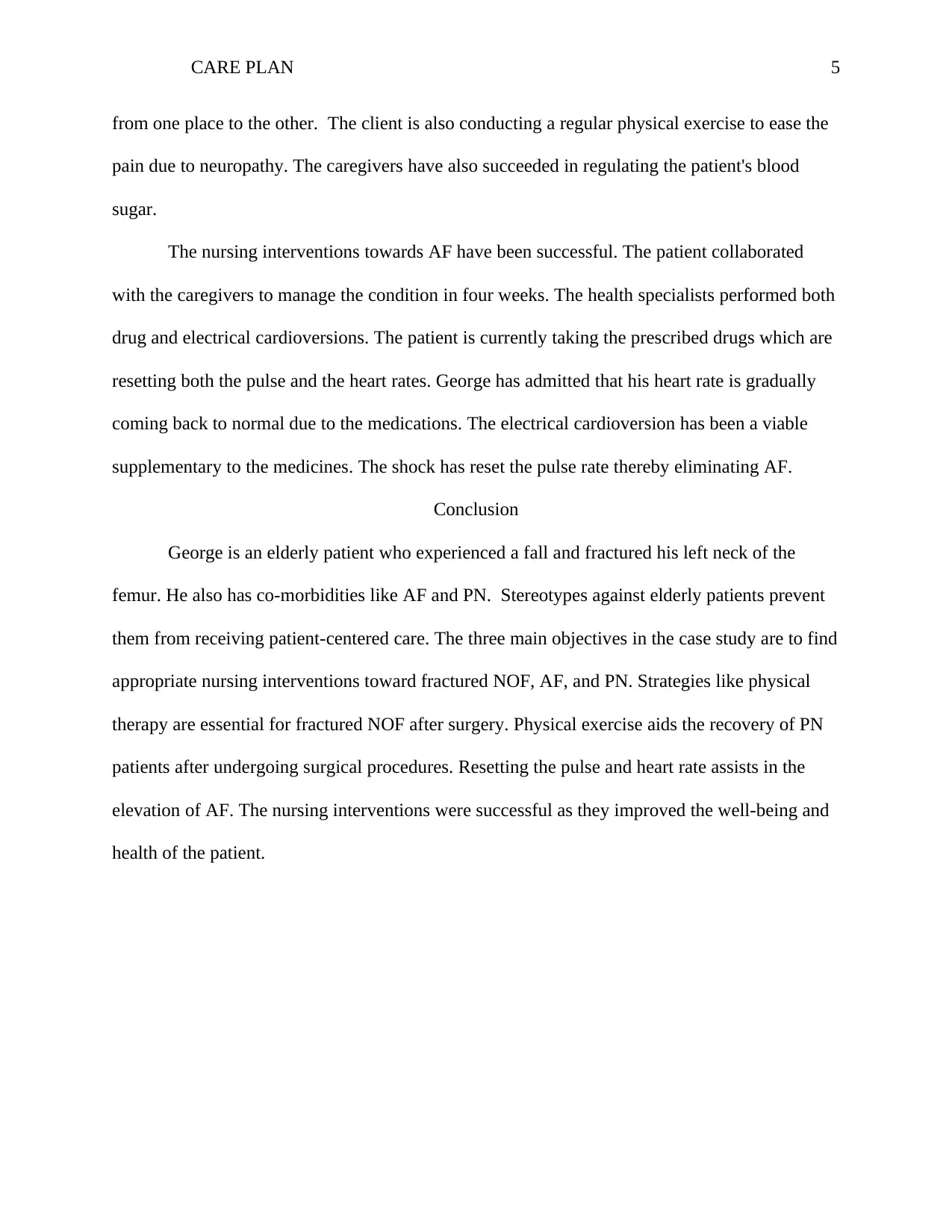
CARE PLAN 5
from one place to the other. The client is also conducting a regular physical exercise to ease the
pain due to neuropathy. The caregivers have also succeeded in regulating the patient's blood
sugar.
The nursing interventions towards AF have been successful. The patient collaborated
with the caregivers to manage the condition in four weeks. The health specialists performed both
drug and electrical cardioversions. The patient is currently taking the prescribed drugs which are
resetting both the pulse and the heart rates. George has admitted that his heart rate is gradually
coming back to normal due to the medications. The electrical cardioversion has been a viable
supplementary to the medicines. The shock has reset the pulse rate thereby eliminating AF.
Conclusion
George is an elderly patient who experienced a fall and fractured his left neck of the
femur. He also has co-morbidities like AF and PN. Stereotypes against elderly patients prevent
them from receiving patient-centered care. The three main objectives in the case study are to find
appropriate nursing interventions toward fractured NOF, AF, and PN. Strategies like physical
therapy are essential for fractured NOF after surgery. Physical exercise aids the recovery of PN
patients after undergoing surgical procedures. Resetting the pulse and heart rate assists in the
elevation of AF. The nursing interventions were successful as they improved the well-being and
health of the patient.
from one place to the other. The client is also conducting a regular physical exercise to ease the
pain due to neuropathy. The caregivers have also succeeded in regulating the patient's blood
sugar.
The nursing interventions towards AF have been successful. The patient collaborated
with the caregivers to manage the condition in four weeks. The health specialists performed both
drug and electrical cardioversions. The patient is currently taking the prescribed drugs which are
resetting both the pulse and the heart rates. George has admitted that his heart rate is gradually
coming back to normal due to the medications. The electrical cardioversion has been a viable
supplementary to the medicines. The shock has reset the pulse rate thereby eliminating AF.
Conclusion
George is an elderly patient who experienced a fall and fractured his left neck of the
femur. He also has co-morbidities like AF and PN. Stereotypes against elderly patients prevent
them from receiving patient-centered care. The three main objectives in the case study are to find
appropriate nursing interventions toward fractured NOF, AF, and PN. Strategies like physical
therapy are essential for fractured NOF after surgery. Physical exercise aids the recovery of PN
patients after undergoing surgical procedures. Resetting the pulse and heart rate assists in the
elevation of AF. The nursing interventions were successful as they improved the well-being and
health of the patient.
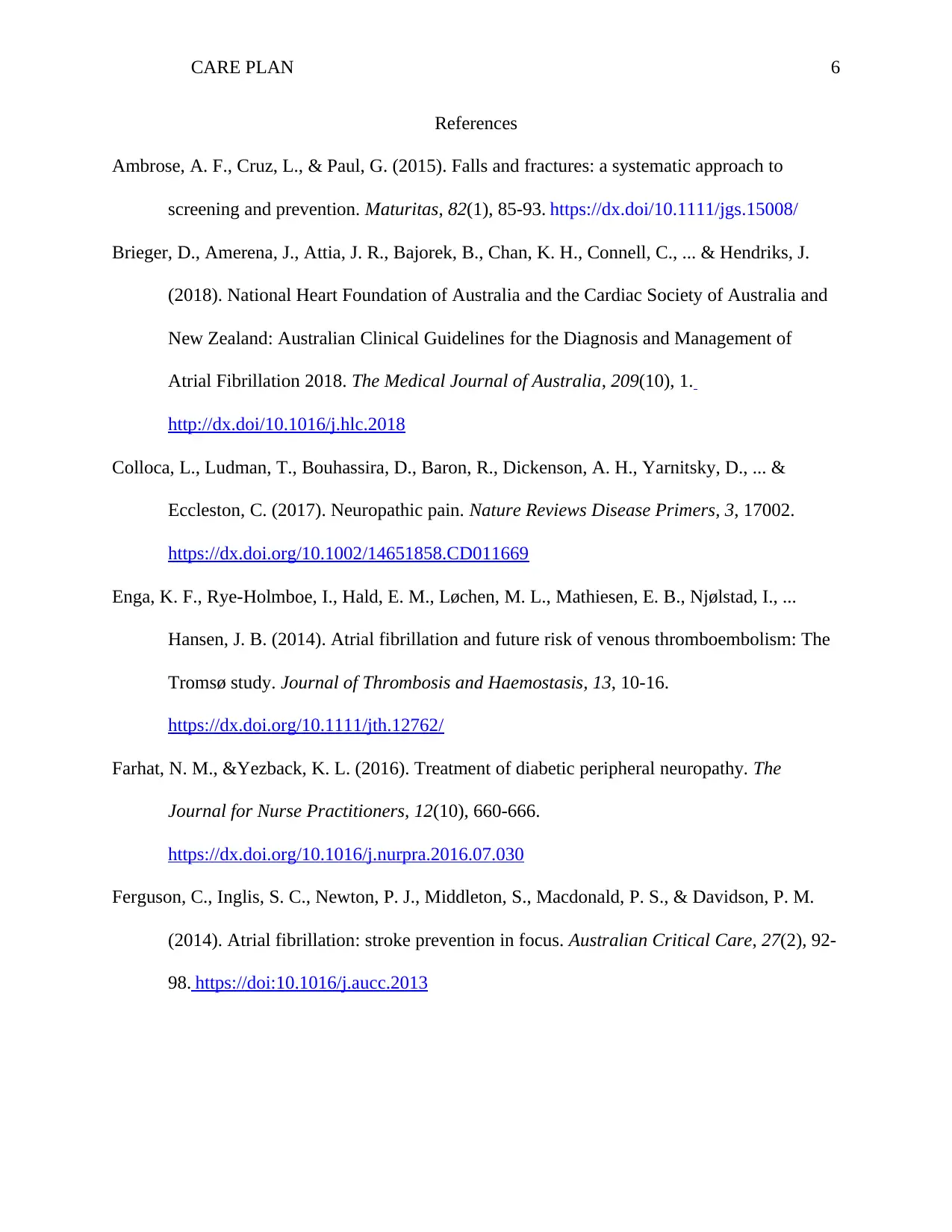
CARE PLAN 6
References
Ambrose, A. F., Cruz, L., & Paul, G. (2015). Falls and fractures: a systematic approach to
screening and prevention. Maturitas, 82(1), 85-93. https://dx.doi/10.1111/jgs.15008/
Brieger, D., Amerena, J., Attia, J. R., Bajorek, B., Chan, K. H., Connell, C., ... & Hendriks, J.
(2018). National Heart Foundation of Australia and the Cardiac Society of Australia and
New Zealand: Australian Clinical Guidelines for the Diagnosis and Management of
Atrial Fibrillation 2018. The Medical Journal of Australia, 209(10), 1.
http://dx.doi/10.1016/j.hlc.2018
Colloca, L., Ludman, T., Bouhassira, D., Baron, R., Dickenson, A. H., Yarnitsky, D., ... &
Eccleston, C. (2017). Neuropathic pain. Nature Reviews Disease Primers, 3, 17002.
https://dx.doi.org/10.1002/14651858.CD011669
Enga, K. F., Rye-Holmboe, I., Hald, E. M., Løchen, M. L., Mathiesen, E. B., Njølstad, I., ...
Hansen, J. B. (2014). Atrial fibrillation and future risk of venous thromboembolism: The
Tromsø study. Journal of Thrombosis and Haemostasis, 13, 10-16.
https://dx.doi.org/10.1111/jth.12762/
Farhat, N. M., &Yezback, K. L. (2016). Treatment of diabetic peripheral neuropathy. The
Journal for Nurse Practitioners, 12(10), 660-666.
https://dx.doi.org/10.1016/j.nurpra.2016.07.030
Ferguson, C., Inglis, S. C., Newton, P. J., Middleton, S., Macdonald, P. S., & Davidson, P. M.
(2014). Atrial fibrillation: stroke prevention in focus. Australian Critical Care, 27(2), 92-
98. https://doi:10.1016/j.aucc.2013
References
Ambrose, A. F., Cruz, L., & Paul, G. (2015). Falls and fractures: a systematic approach to
screening and prevention. Maturitas, 82(1), 85-93. https://dx.doi/10.1111/jgs.15008/
Brieger, D., Amerena, J., Attia, J. R., Bajorek, B., Chan, K. H., Connell, C., ... & Hendriks, J.
(2018). National Heart Foundation of Australia and the Cardiac Society of Australia and
New Zealand: Australian Clinical Guidelines for the Diagnosis and Management of
Atrial Fibrillation 2018. The Medical Journal of Australia, 209(10), 1.
http://dx.doi/10.1016/j.hlc.2018
Colloca, L., Ludman, T., Bouhassira, D., Baron, R., Dickenson, A. H., Yarnitsky, D., ... &
Eccleston, C. (2017). Neuropathic pain. Nature Reviews Disease Primers, 3, 17002.
https://dx.doi.org/10.1002/14651858.CD011669
Enga, K. F., Rye-Holmboe, I., Hald, E. M., Løchen, M. L., Mathiesen, E. B., Njølstad, I., ...
Hansen, J. B. (2014). Atrial fibrillation and future risk of venous thromboembolism: The
Tromsø study. Journal of Thrombosis and Haemostasis, 13, 10-16.
https://dx.doi.org/10.1111/jth.12762/
Farhat, N. M., &Yezback, K. L. (2016). Treatment of diabetic peripheral neuropathy. The
Journal for Nurse Practitioners, 12(10), 660-666.
https://dx.doi.org/10.1016/j.nurpra.2016.07.030
Ferguson, C., Inglis, S. C., Newton, P. J., Middleton, S., Macdonald, P. S., & Davidson, P. M.
(2014). Atrial fibrillation: stroke prevention in focus. Australian Critical Care, 27(2), 92-
98. https://doi:10.1016/j.aucc.2013
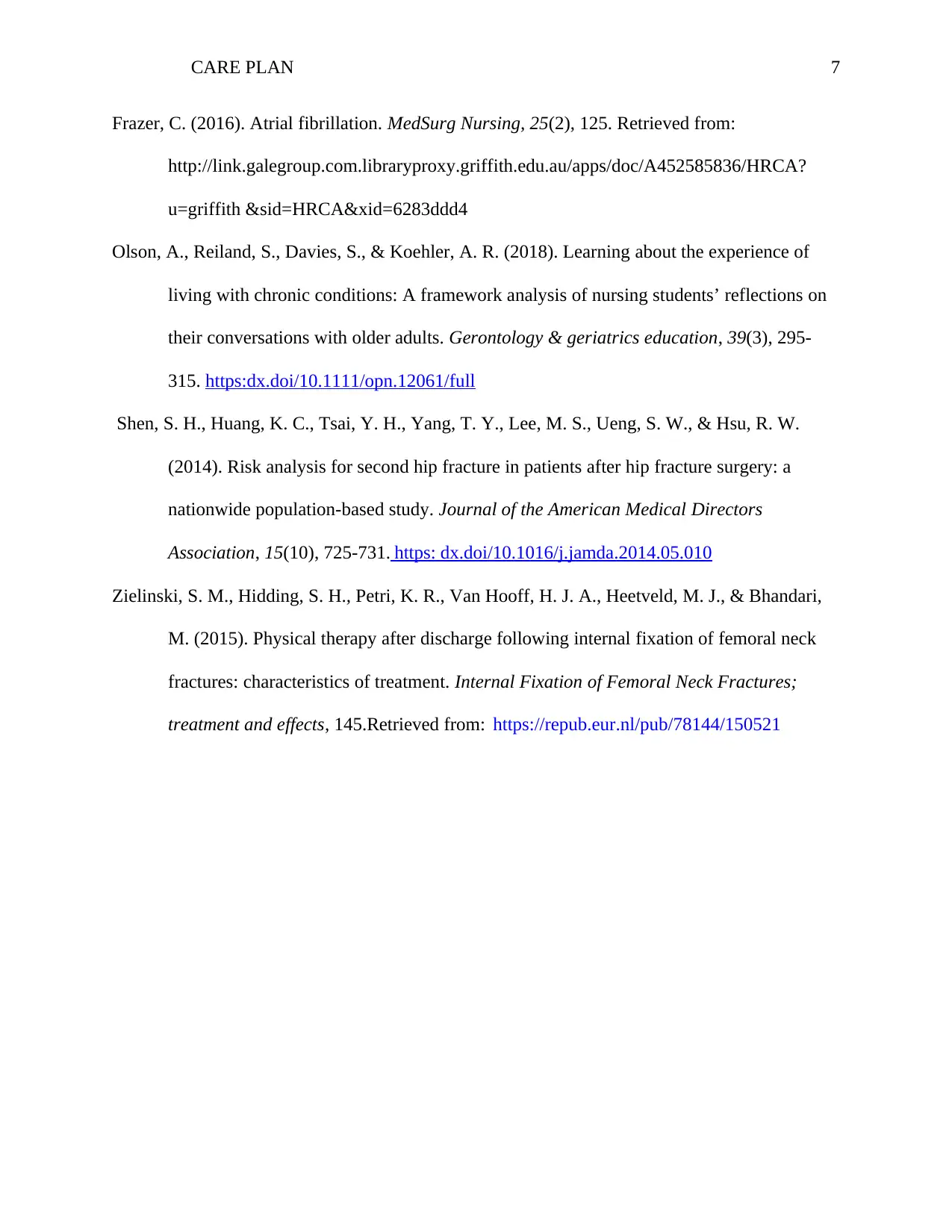
CARE PLAN 7
Frazer, C. (2016). Atrial fibrillation. MedSurg Nursing, 25(2), 125. Retrieved from:
http://link.galegroup.com.libraryproxy.griffith.edu.au/apps/doc/A452585836/HRCA?
u=griffith &sid=HRCA&xid=6283ddd4
Olson, A., Reiland, S., Davies, S., & Koehler, A. R. (2018). Learning about the experience of
living with chronic conditions: A framework analysis of nursing students’ reflections on
their conversations with older adults. Gerontology & geriatrics education, 39(3), 295-
315. https:dx.doi/10.1111/opn.12061/full
Shen, S. H., Huang, K. C., Tsai, Y. H., Yang, T. Y., Lee, M. S., Ueng, S. W., & Hsu, R. W.
(2014). Risk analysis for second hip fracture in patients after hip fracture surgery: a
nationwide population-based study. Journal of the American Medical Directors
Association, 15(10), 725-731. https: dx.doi/10.1016/j.jamda.2014.05.010
Zielinski, S. M., Hidding, S. H., Petri, K. R., Van Hooff, H. J. A., Heetveld, M. J., & Bhandari,
M. (2015). Physical therapy after discharge following internal fixation of femoral neck
fractures: characteristics of treatment. Internal Fixation of Femoral Neck Fractures;
treatment and effects, 145.Retrieved from: https://repub.eur.nl/pub/78144/150521
Frazer, C. (2016). Atrial fibrillation. MedSurg Nursing, 25(2), 125. Retrieved from:
http://link.galegroup.com.libraryproxy.griffith.edu.au/apps/doc/A452585836/HRCA?
u=griffith &sid=HRCA&xid=6283ddd4
Olson, A., Reiland, S., Davies, S., & Koehler, A. R. (2018). Learning about the experience of
living with chronic conditions: A framework analysis of nursing students’ reflections on
their conversations with older adults. Gerontology & geriatrics education, 39(3), 295-
315. https:dx.doi/10.1111/opn.12061/full
Shen, S. H., Huang, K. C., Tsai, Y. H., Yang, T. Y., Lee, M. S., Ueng, S. W., & Hsu, R. W.
(2014). Risk analysis for second hip fracture in patients after hip fracture surgery: a
nationwide population-based study. Journal of the American Medical Directors
Association, 15(10), 725-731. https: dx.doi/10.1016/j.jamda.2014.05.010
Zielinski, S. M., Hidding, S. H., Petri, K. R., Van Hooff, H. J. A., Heetveld, M. J., & Bhandari,
M. (2015). Physical therapy after discharge following internal fixation of femoral neck
fractures: characteristics of treatment. Internal Fixation of Femoral Neck Fractures;
treatment and effects, 145.Retrieved from: https://repub.eur.nl/pub/78144/150521
1 out of 7
Your All-in-One AI-Powered Toolkit for Academic Success.
+13062052269
info@desklib.com
Available 24*7 on WhatsApp / Email
![[object Object]](/_next/static/media/star-bottom.7253800d.svg)
Unlock your academic potential
© 2024 | Zucol Services PVT LTD | All rights reserved.